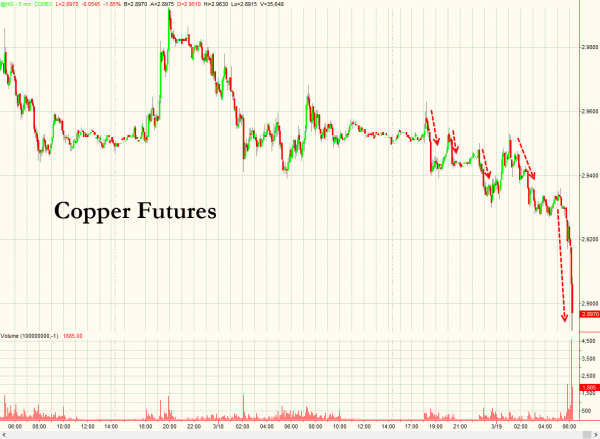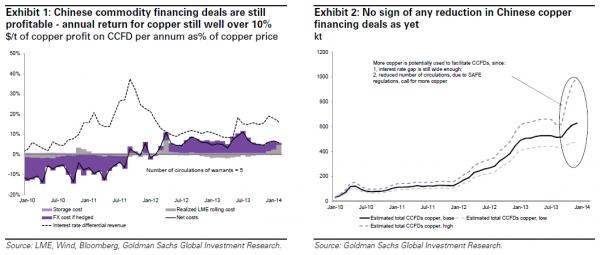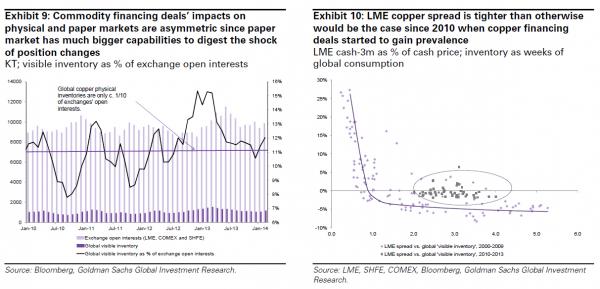Copper Plunges To Fresh 5-Year Low
March 28, 2014 Leave a comment
Copper Plunges To Fresh 5-Year Low
Tyler Durden on 03/19/2014 09:20 -0400
As we explained in great detail yesterday, the selling in commodities is far from over. The extent of China’s commodity-backed-financing is only now beginning to be understood and forced sales (along with the vicious circle of collapsing collateral values and increasingly tightening credit) are hard to stop for a government set of reform. Copper prices were heavy overnight in Asia but this morning has seen futures plunge on heavy volume below $289 – the lowest since July 2009- breaking key support levels. For the same reasoning, zinc and aluminum are under pressure, as is steel rebar and gold.
Which has dropped copper prices to 5-year lows…(breaking critical support)
What Is The Common Theme: Iron Ore, Soybeans, Palm Oil, Rubber, Zinc, Aluminum, Gold, Copper, And Nickel?
Tyler Durden on 03/18/2014 19:53 -0400
If you said a short list of commodities manipulated by the Too Big To Prosecute banks, you are probably right, but the answer we were looking for is that these are all the various, and increasingly more ridiculous, commodities that serve to make up the bulk of China’s hot money flow (those flows into China which are not reflected in the current account flows or FDI) facilitating synthetic structures, also known asChinese Commodity Funding Deals.
Of these the copper “monetary metal” funding pathway is best known, and in fact we covered the inevitable end of the Chinese Copper Financing Deals in gruesome detail last May in “The Bronze Swan Arrives: Is The End Of Copper Financing China’s “Lehman Event.” What happened next was that despite repeated warnings by the PBOC and SAFE that it would end the hot money inflows masked by funding deals, China not only encouraged more CCFDs but aggressively expanded into other commodities, such as iron ore, and as we now learn, weird and wacky commodities such the abovementioned soybeans, palm oil, rubber, zinc, aluminum, gold and nickel. To be sure this was largely precipitated by the near collapse in the overnight lending market in June of 2013 when China’s first and so far only real tapering attempt nearly destroyed the domestic financial system.
So what has changed since last May, in addition to the realization that virtually every hard asset is now being used by China to mask hot money inflows into the Chinese economy taking advantage of rate differentials between the Renminbi and the Dollar? Well, this time around China may finally be serious about normalizing its epic credit bubble, which as we pointed out before, added a ridiculous $1 trillion in bank assets in just the fourth quarter of 2013 alone. Specifically, as Goldman notes in a just released analysts on the future of CCDS, “the recent managed CNY depreciation is a signal that the government wants to increase FX volatility and reduce the hot money inflow pressure gradually.”
In other words, the day when the Commodity Funding Deals finally end is fast approaching.
Here is Goldman’s take on what will certainly be a watershed event – one which will certainly dwarf the recent Chaori Solar default in its significance and scale.
Financing deal concerns mounting as CNY volatility rises
Concerns on an unwind of commodity financing deals trigger selloff
The recent sell-off in copper and iron ore prices reflects the market’s ongoing concerns regarding the impact of a potential unwind of Chinese commodity financing deals, though the weak underlying market fundamentals should not be discounted. The concerns intensified following the recent CNY depreciation which has raised uncertainty regarding the profitability of the deals and the impact on different asset classes were they to unwind. Up to 1mt of copper and 30mt of iron ore could be released were the deals to unwind, which would be bearish given the relatively limited physical liquidity to absorb the shock.
CCFDs are facilitating China’s total credit growth
We believe CCFDs are ongoing and facilitating ‘hot money’ inflows into China by providing a mechanism to import low-cost foreign financing. In general, the profitability of most hedged commodity financing deals remains substantial (iron ore is the exception), due to a still positive CNY and USD interest rate differential, limited depreciation in the CNY forward curve and available commodity supply. In 2013, ‘hot money’ accounted for c. 42% of the growth in China’s monetary base of which we estimate that CCFDs contributed US$81-160 bn or c.31% of China’s total FX short-term loans. Given this, it is crucial for the government to manage the immediate impact of ‘hot money’ flow changes on the economy and markets.
More commodities are used; a medium-term unwind is bearish
An increasing range of commodities are being used to raise foreign financing, which now includes iron ore, soybeans, palm oil, rubber, zinc, and aluminum, as well as gold, copper, and nickel. CCFDs create excess physical demand and tighten the physical markets artificially; in contrast, an unwind creates excess supply and thus is bearish to prices. We think CCFDs will be unwound over the medium term, mainly triggered by an increase in Chinese FX volatility, as indicated by recent CNY depreciation and PBOC’s latest move to widen the daily trading band. FX volatility could result in a higher cost of currency hedging, effectively closing the interest rate arbitrage. Higher US rates are another likely catalyst for an unwind in the long run.A continuous CNY depreciation in the short term, however, would trigger some deals to be unwound sooner than expected, and hence place downside risks to our short-term commodity price forecasts.
It should now become apparent why the ongoing sharp devaluation of the CNY, far more than merely impacting a few massively levered speculators, and recall that the European Knock In point of maximum vega is about USDCNY 6.20 as discussed previously, will have a far more broad hit to asset levels not just in China but across the world if and when the inevitable moment of CCFD unwind finally begins, and in a reflexive fashion, initial selling begets more selling, more CNY devaluation, greater margin calls, further CCFD unwinds, and so on, until finally the PBOC has no choice but to come in and bail out the financial system one more time.
For those unfamiliar with the concept of CCFD, and too lazy to read our previous article on the topic, here is Goldman’s Roger Yuan with a succinct summary of just why these key component of China’s shadow funding mechanism are so important on the way up… and down.
Days numbered for Chinese commodity financing deals
As part of a broader shift in China’s funding base from domestic to various foreign funding vehicles, Chinese commodity financing deals have become increasingly prevalent, owing to the combination of the relatively high level of Chinese interest rates and the existence of Chinese capital controls. Financing deals use commodities and other goods as a tool to unlock the interest rate differential, with potential implications for Chinese growth, China’s linkage with ex-China interest rates, CNY volatility and commodity market pricing.
In contrast to some media reports, we find that the bulk of Chinese commodity financing deals are ongoing, facilitating ‘hot money’ inflows into China and providing a mechanism to import low cost foreign financing. In general, the profitability of most currency and commodity hedged Chinese commodity financing deals remains substantial, owing to a still positive CNY and USD based interest rate differential (>4%), limited depreciation in the CNY over the past month (<2%) and the CNY forward curve (limited cost of hedging the currency exposure), and a lack of tightness in the underlying commodity (i.e. limited cost of hedging the commodity). Returns in copper are still >10% (Exhibit 1), and up to 1mt of physical copper could still be tied up in deals (Exhibit 2).
While triggered by concerns about Chinese credit following the Chaori default, an unwind in iron ore financing deals, and concerns about an unwind in copper financing deals, the recent copper price weakness has reflected the combination of sluggish Chinese demand growth and strong global copper supply growth, rather than a financing deal unwind. Supporting this assertion is the fact that nickel (to an even greater extent than copper), and zinc both have a sizeable amount of exposure to financing deals, and their prices have substantially outperformed copper. Further, were this a true copper financing deal unwind, Chinese bonded copper prices would have led the price declines (instead they lagged the domestic Shanghai copper price declines), Chinese bonded stocks would have declined (instead they have risen) and the LME futures curve would likely have moved into contango (it remains in backwardation).
More broadly, the main reason why the government has not shut down ‘hot money’ inflows in an abrupt fashion to date, in our opinion, is that a complete shutdown could have major consequences for China’s short-term liquidity. Indeed, China’s economic growth is increasingly supported by different types of FX inflows, including those from commodity financing deals, as they can bring in low cost foreign funding and increase China’s monetary base, the foundation of both China’s rapid credit growth and solid economy growth. In 2013, we estimate that c.42% of the increase of China’s monetary base can be attributed to the low cost foreign funding or the ‘hot money’ inflows (Exhibit 3).

These FX / hot money inflows are of substantial size and high volatility (Exhibit 4) and the government attempts to smoothly manage the short-term liquidity cycle in response to these flows. When these flows are very strong China tends to respond (Exhibit 5), as in June and December 2013, as well as February/March 2014, with bearish implications for equities and commodities (Exhibit 6).
There are three main drivers of ‘hot money’ inflows: commodity financing deals, overinvoicing exports, and the black market. In this article, we focus on the Chinese commodity financing deal channel, which has by our estimates facilitated roughly US$81-160 bn of FX inflows since 2010, which is c.31% of China’s total FX short-term borrowings (duration < 1 year) (Exhibit 7). Of these deals, gold, copper and iron ore are three leading commodities, followed by soybean, palm oil, natural rubber, nickel, zinc and aluminum.
One reason why the range of commodities and the amount of each of those commodities being used for financing purposes has increased since mid-2013 is that the Chinese government moved to reduce the amount of money that can be borrowed per commodity unit. This reduction in apparent financing deal ‘leverage’6 (to c.3-10 times the value of the commodity from much higher levels a year ago), has meant that larger amounts of commodities are needed to raise the same amount of low cost foreign funding. In copper’s case for example, the amount of copper used in financing deals could have risen from 500kt to 1mt over the past nine months, as shown in Exhibit 2.
Looking ahead, our view is that Chinese commodity financing deals will gradually unwind over the medium term (the next 12-24 months), driven by an increase in FX hedging costs, which would slowly erode financing deal profitability and eventually close the interest rate arbitrage. Indeed, we expect that the government will continue to increase FX volatility in order to manage the hot money inflow cycle, thus increasing FX hedging among broader market participants, and raising the cost of hedging the currency for commodity financing deals. This FX policy outlook would be in line with the government’s policy targets of gradually increasing the CNY trading band before eventually loosening the nation’s capital controls, and is likely to occur before the CNY/USD interest rate differentials close, based on our Economists’ forecasts. Finally, an abrupt government crackdown on Chinese commodity financing deals, even with an offsetting monetary stimulus package, is unlikely in our view, given the potential negative impact this could have on credit and thus economic growth.
With respect to the impact of an unwind in Chinese commodity financing deals on China’s economic growth, we expect that the government will actively manage the impact on domestic credit creation, however we note that this process, if not managed perfectly, will not be without downside risks to Chinese growth.
From a commodity market perspective, financing deals create excess physical demand and tighten the physical markets, using part of the profits from the CNY/USD interest rate differential to pay to hold the physical commodity. While commodity financing deals are usually neutral in terms of their commodity position owing to an offsetting commodity futures hedge, the impact of the purchasing of the physical commodity on the physical market is likely to be larger than the impact of the selling of the commodity futures on the futures market (ZH: unless of course momentum algos take offsetting commodity futures hedge selling in, say, gold and boost, or “ignite” the downward momentum to a far greater degree than the offsetting physical buying, making a recursive pattern whereby buying physical ends up resulting in a lower physical price as has been the case with gold over the past year). This reflects the fact that physical inventory is much smaller than the open interest in the futures market (Exhibit 9). As well as placing upward pressure on the physical price, Chinese commodity financing deals ‘tighten’ the spread between the physical commodity price and the futures price (Exhibit 10).
In this context, an unwind of Chinese commodity financing deals would likely result in an increase in availability of physical inventory (physical selling), and an increase in futures buying (buying back the hedge) – thereby resulting in a lower physical price than futures price, as well as resulting in a lower overall price curve (or full carry) (Exhibit 11).







